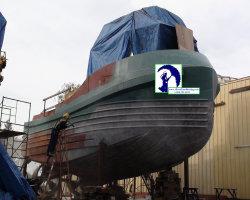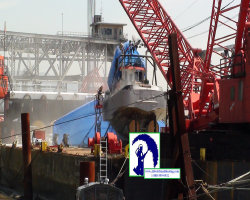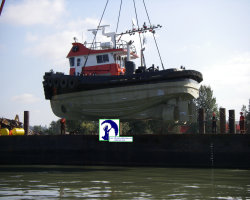Sandblasting fiberglass boat bottoms removes the top layer of gel coat to expose air bubbles. leaving the surface ready to except marine coatings. Sandblasting other metals such as steel leaves surface profiles which paint manufacturers use to determine productivity of the product.
Preparing Your Boat for Bottom Paint
If your boat's bottom paint has deteriorated it is important to have the surface prepared prior to applying future coatings. Sandblasting is a safe, cost effective way of having the boats surface prepared. Experienced blasters use various abrasive capable of removing paint, contaminate and debris without damage to the vessel. This preparation will insure bonding and guarantee the life of the marine coating. Improper surface preparation may result in coatings failure. It is important that you hire a professional to strip the existing paint from the boat. The existing paint may contain hazardous chemicals which need to be dealt with not only for safety purposes but also environmental.
Most boat yards have facilities that will pressure wash and/or sandblast. However having a independent company provide these services may help keep your costs down.
Preparing the surface of a boat:
When preparing the surface of a boat the sandblaster must first understand clearly the needs of the customer. After the initial consultation the preparation of the area can begin. Depending on the area where the sandblasting will take place the customer may want to consider containment. Containment solutions are discussed further on our containment page.
Surface preparation refers to the elimination of dirt, debris, paint, rust, marine life, mile scale..or other contaminates leaving the surface in an ideal state for the application of future marine coating. When Sandblasting steel boats for the purpose of marine coatings the sandblaster will need to follow specific specifications provided by the coatings manufacturer. Steel surface preparation standards are measured by two critical specifications: Surface profile and Degrees of Cleanliness.
Surface Profile:
Profile refers the scratch depth that the abrasive leaves on the steel surface. Abrasives cut into the steel forming peaks and valleys. The depth of the profile is controlled by the size of the abrasive, angle of nozzle, distance of nozzle to surface and compressed air flow. The profile provides a mechanical method of positive, uniform bonding between the coating and the surface.
Coating manufacturers test their coatings on various profiles making sure that their products perform as intended. Adhesion and performance of coatings are guaranteed if specifications are followed. Contractors must adhere to these specifications. When profiles exceed the maximum specifications, the peaks may protrude through the coating system, causing it to fail.
Degrees of Cleanliness
The Steel Structures Painting Council (SSPC) has established four degrees of cleanliness for blasting, ranging from removal of all contaminants to removal of loos materials only. The four degrees are White Metal Blast, Near White Metal Blast, Commercial Blast, and Brush off Blast For detailed descriptions of each refer to the SSPC's Visual Standards for Abrasive Blast Cleaned Steel.
White Metal Blast
Viewed without magnification, a shite metal blast cleaned surface is free of all visible rust, mill scale, paint, and foreign mater. This degree of cleanliness is usually required where sophisticated points; such as, zinc-rich coatings, will be applied to surfaces exposed to highly corrosive environments. Chemical plants, offshore drilling rigs, and bridges over salt water are typical applications.
Near White Metal Blast
Viewed without magnification, at least 95% of the surface is free of all visible residue after blast cleaning. This is similar to White Metal but some slight staining on the metal is allowed. This degree of cleaning is required where high performance coatings will be applied to steel exposed to harsh elements and heavy usage.
Commercial Blast
Viewed without magnification, at least two thirds of a commercial blast cleaned surface is free of visible residue. It allows some tightly adhering old paint to remain, based on the premise that paint adheres after blasting is unlikely to fail. For most applications where standard coatings will be applied, commercial blast is specified.
Brush Off Blast
Viewed
without magnification a brush off blast cleaned surface may have only tightly adhering residues of mill scale, rust, and coatings
remaining and must have numerous evenly distributed flecks of underlying metal exposed. This method is acceptable for surfaces not
subjected to sever environments or where long-term coating life is not expected
|
Degrees of Cleanliness |
SSPC Std. |
NACE Std. |
SIS Std. |
|
White Metal Blast |
SSPC-SP 5 |
NACE No. 1 |
SA-3 |
|
Near White Metal Blast |
SSPC-SP 10 |
NACE No. 2 |
SA-2 1/2 |
|
Commercial Blast |
SSPC-SP 6 |
NACE No. 3 |
SA-2 |
|
Brush-off Blast |
SSPC-SP 7 |
NACE No. 4 |
SA-1 |







